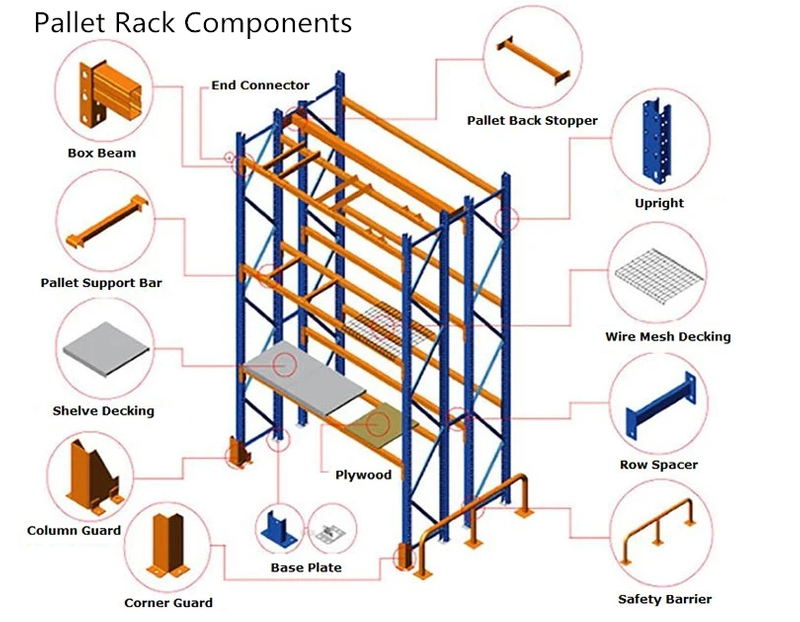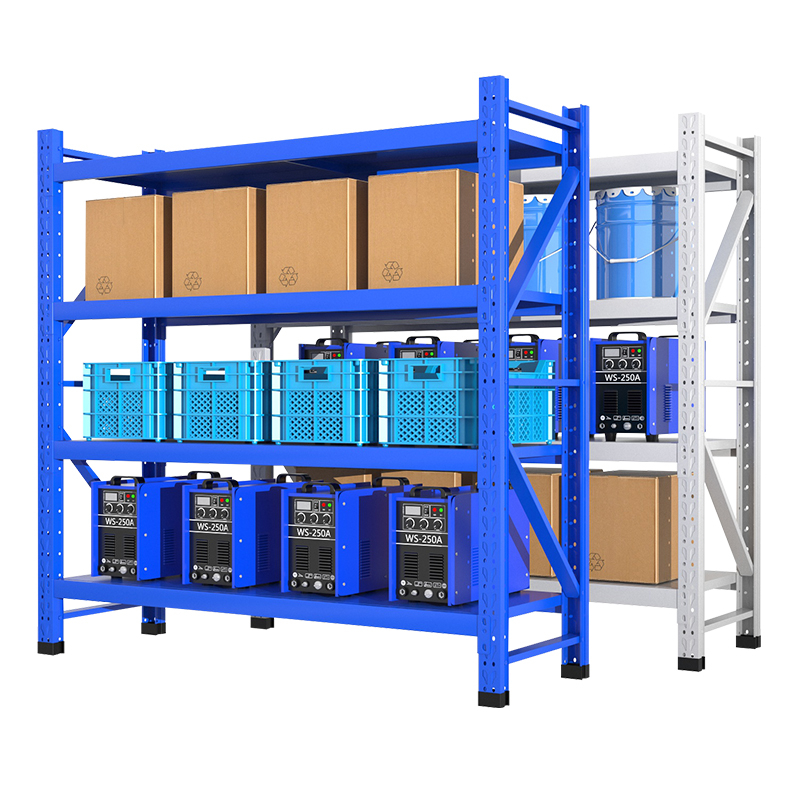- All
- Product Name
- Product Keyword
- Product Model
- Product Summary
- Product Description
- Multi Field Search
Views: 0 Author: Site Editor Publish Time: 2025-07-02 Origin: Site









Are you struggling to make the most of your warehouse space? Logistic metal shelving/racks could be the solution.
These shelving systems are designed to improve organization, maximize storage, and streamline inventory management. In this post, we’ll discuss how they help optimize warehouse operations and enhance efficiency.

Heavy-duty logistic shelving is built to support large, bulky items with high weight capacity. These racks are often made of robust materials like steel or heavy-duty alloys, ensuring maximum strength and durability. With weight capacities that can exceed several tons, they are ideal for storing heavy products such as industrial equipment or machinery parts.
Many industries, including e-commerce and manufacturing, customize these racks to fit their specific needs. For example, adjustable height or shelf configurations allow flexibility to store a variety of goods. The key benefits of heavy-duty shelving include:
● Enhanced durability: Built to last, even under heavy load.
● Efficient space utilization: Maximizes vertical space in warehouses.
For instance, this Black Longspan Shelving Rack offers high weight capacity and customization options, ideal for heavy-duty storage needs.
Cantilever shelving is a unique system designed to store long or irregularly shaped items. These racks feature an open structure with extendable arms, making them perfect for materials like pipes, lumber, or metal rods. With no front posts to obstruct access, items are easily placed and retrieved.
The open design also allows for flexible layout configurations. This versatility makes cantilever shelving ideal for warehouses with products that require extra space. Key benefits include:
● Optimized space usage: Great for long or oversized items.
● Layout flexibility: Easily adjustable to suit warehouse needs.
Shuttle shelving systems are designed for high-density storage, utilizing pallet shuttles that move goods automatically. This setup makes it possible to store more items in less space, increasing overall storage capacity. In addition, these systems speed up product retrieval by automating the process, which is perfect for environments that require fast inventory turnover.
Shuttle racks are particularly useful in cold chain logistics, where fast and efficient retrieval of temperature-sensitive goods is crucial. They help improve storage efficiency by maximizing available space and improving operational speed. The main benefits of shuttle shelving include:
● Space efficiency: High-density storage reduces wasted space.
● Faster product retrieval: Automation boosts inventory speed.
● Cold chain logistics: Ensures quick access to perishable goods.
Flow racking systems utilize a gravity-fed design, allowing products to move automatically from the back to the front of the rack. This setup works perfectly for warehouses handling perishable goods, as it supports the First In, First Out (FIFO) inventory method, ensuring older products are used before newer ones.
By reducing manual labor, flow racking boosts operational efficiency and cuts down on labor costs. It's particularly effective for industries like food storage or pharmaceuticals, where managing stock expiration is critical. Benefits of flow racking include:
● FIFO inventory management: Ensures products are used in the correct order.
● Operational efficiency: Reduces the need for manual labor.
● Cost savings: Cuts down on time and manpower needed for product handling.
Logistic metal shelving systems help optimize space by making the most of both vertical and horizontal storage. By utilizing the full height of a warehouse, they maximize storage capacity without requiring more floor space. For example, stacking pallets on heavy-duty racks or using narrow aisles with adjustable shelving creates more room for goods.Standard sizes like this 2000×600×2000mm Steel Longspan Shelving Rack efficiently utilize vertical space, minimizing waste.
Space optimization is crucial for warehouse success. Wasting valuable square footage can hurt operational capacity and increase costs. Efficient shelving systems lead to smoother workflows, allowing for better organization and faster operations, ultimately improving warehouse efficiency.
Logistic metal racks speed up product retrieval by incorporating technology like RFID, barcodes, and automation. Systems like shuttle racks or gravity-fed shelving allow goods to be quickly moved from one location to another, reducing the time spent searching for items. Fast retrieval methods cut down on labor costs and help improve inventory accuracy by reducing the chance of human error.
With fast access, product visibility is improved, and stock discrepancies are minimized. By ensuring items are easily accessible, warehouse workers can quickly retrieve products, reducing overall labor costs.
Efficient shelving plays a key role in improving inventory accuracy by reducing misplacement and shrinkage. Organized racks make it easier to identify and track products, preventing stockouts and overstocking. Integration with Warehouse Management Systems (WMS) allows for real-time tracking, giving warehouse managers better visibility of stock levels.
For example, with IoT-enabled smart shelving, real-time updates help keep inventory levels balanced, preventing understocking or overstocking. This technology helps reduce discrepancies and ensures smoother inventory management across the entire warehouse.
Automation has revolutionized warehouse operations by integrating robotic systems with logistic metal shelving. Automated Storage and Retrieval Systems (ASRS) are commonly used with shelving to increase efficiency. These systems automatically store and retrieve items, reducing the need for manual labor.
For large-scale warehouse operations, automation boosts productivity by speeding up product retrieval and improving inventory accuracy. Companies like Amazon and Walmart have successfully implemented automated shelving systems, showcasing faster processing times and cost reductions. These systems allow for smoother operations and more efficient use of space.
Smart shelving uses advanced technology like sensors, IoT devices, and RFID tags to track inventory in real time. With these systems, warehouse managers can monitor the exact location and status of items on the shelves. This improves stock accuracy and makes managing the flow of goods much easier.
The future of smart shelving looks promising. Predictive maintenance, condition monitoring, and inventory forecasting are just a few benefits that come with IoT integration. As these technologies evolve, they will offer even more ways to streamline operations and reduce downtime.
Green technologies are starting to play a major role in logistic shelving. Many companies now prioritize eco-friendly materials, such as recyclable metals, for manufacturing shelving systems. This focus on sustainability reduces environmental impact and lowers energy consumption.
Energy-efficient shelving systems help reduce operational costs while benefiting the environment. As sustainability becomes a key factor in business decisions, more companies are seeking shelving solutions that align with their eco-friendly goals. The demand for long-lasting, low-maintenance, and recyclable shelving is growing, pushing the industry toward more sustainable practices.

When selecting logistic metal shelving, it’s essential to assess the weight and size requirements for the shelves. Consider the types of goods you’ll be storing and the weight each shelf needs to support. For instance, heavy-duty shelves are needed for large, bulky items, while lighter shelves work for smaller goods.
Choosing the right shelving based on the volume and size of your inventory ensures that the shelves can handle the load without risking damage. Properly rated shelving will also improve overall efficiency by allowing easier access to goods.
Logistic metal shelving systems are typically made from materials like steel, galvanized coatings, and corrosion-resistant alloys. These materials are essential for ensuring long-lasting strength and functionality. Selecting the right material depends on the specific warehouse conditions, such as temperature, humidity, and exposure to corrosive substances.
Durability is a key factor for long-term investments. Choosing shelves that last longer will prevent frequent replacements and costly maintenance. It’s important to ensure the material you select can withstand the demands of your warehouse environment.
Shelving should be tailored to fit the unique needs of your warehouse. Customization options include adjustable height, modular designs, and special configurations to accommodate different inventory types. Flexible shelving systems adapt to changes in inventory, allowing you to adjust as needed.For example, this Custom-Made Medium-Duty Longspan Shelving Rack offers modular design to flexibly adapt to cargo dimensions, meeting personalized requirements.
This customization ensures that your warehouse can evolve over time, keeping it optimized for various storage requirements.
When evaluating the cost of logistic metal shelving, consider both the initial investment and the long-term savings. While higher-quality shelving may come with a higher price tag, it can save money in the long run by improving operational efficiency and reducing maintenance costs.
Performing a cost-benefit analysis helps to understand the return on investment (ROI) for different shelving systems. Compare the costs of various options to determine which system provides the most value for your warehouse's specific needs.
Logistic metal shelving improves warehouse management by optimizing space, increasing retrieval speed, and enhancing inventory accuracy. Different types of shelving, such as heavy-duty, cantilever, and shuttle racks, all contribute to operational efficiency.
Choosing the right shelving system depends on your business needs. Future trends will focus on automation, technology, and eco-friendly solutions for sustainable warehouse operations.Explore more shelving solutions at our website.
A: Logistic metal shelving refers to shelving systems made of metal used for organizing and storing inventory in warehouses, improving space efficiency and inventory management.
A: It optimizes space, increases retrieval speed, and ensures better inventory control by organizing items for easy access and tracking.
A: Heavy-duty racks, cantilever racks, shuttle racks, and flow racking are popular types, each serving specific storage needs.
A: Yes, many systems offer customization for size, weight capacity, and layout to suit different types of goods and warehouse configurations.
A: Automation systems, such as automated storage and retrieval systems (ASRS), integrate with shelving to speed up product retrieval and improve inventory management.





